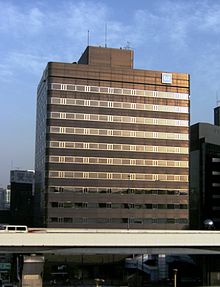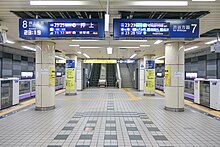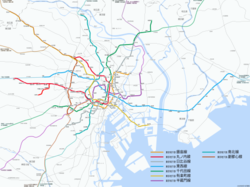Tokyo Metro
This article needs additional citations for verification. (May 2014) |
| Tokyo Metro | |||
|---|---|---|---|
Tōzai Line )65 km/h (40 mph) (Ginza Line) 75 km/h (47 mph) (Marunouchi Line) | |||
| |||
The Tokyo Metro (Japanese: 東京メトロ, Tōkyō Metoro) is a major
Organization


Tokyo Metro is operated by the Tokyo Metro Co., Ltd. (東京地下鉄株式会社, Tōkyō Chikatetsu kabushiki-gaisha), a joint-stock company jointly owned by the Government of Japan and the Tokyo Metropolitan Government.
The company, founded as a part of then-Prime Minister
The other major subway operator is Tokyo Metropolitan Bureau of Transportation (Toei Subway) which is owned solely by the government of Tokyo. Tokyo Metro and Toei trains form completely separate networks, although Tokyo Metro Namboku Line and Toei Mita Line share the same track between Meguro Station and Shirokane-takanawa Station. Users of prepaid rail passes and Suica/Pasmo smart cards can freely interchange between the two networks (as well as other rail companies in the area), but fares are assessed separately for legs on each of these systems and regular ticket holders must purchase a second ticket, or a special transfer ticket, to change from a Toei line to a Tokyo Metro line and vice versa. Though, most Tokyo Metro (and Toei) line offer through service to lines outside of central Tokyo run by other carriers, and this can somewhat complicate the ticketing.
Much effort has been made to make the system accessible to non-Japanese speaking users:
- Many train stops are announced in both English and Japanese. Announcements also provide connecting line information.
- Ticket machines can switch between English and Japanese user interfaces.
- Train stations are signposted in English and Japanese (in simplified characters) and Korean.
- Train stations are now also consecutively numbered on each color-coded line, allowing even non-English speakers to be able to commute without necessarily knowing the name of the station. For example, Shinjuku Station on the Marunouchi Line is also signposted as M-08 with a red colored circle surrounding it; even if a commuter could not read the English or Japanese station names on signs or maps, they could simply look for the red line and then find the appropriately numbered station on said line. In addition, some trains have interior LCD displays which display station names in Japanese, English, Chinese, and Korean.
Many stations are also designed to help blind people as railings often have Braille at their base, and raised yellow rubber guide strips are used on flooring throughout the network.
Tokyo Metro stations began accepting contactless (
system is also universally accepted. Both these passes also can be used on surrounding rail systems throughout the area and many rail lines in other areas of Japan. Due to the complexity of the fare systems in Japan, most riders converted to these cards very quickly even though there is an additional charge to issue it.The Tokyo Metro is extremely punctual and has regular trains arriving 3 to 6 minutes apart most of the day and night. However, it does not run 24 hours a day. While through service with other companies complicates this somewhat, the last train generally starts at midnight and completes its service by 00:45 to 01:00, and the first train generally starts at 05:00.
Tokyo Metro indicated in its public share offering that it would cease line construction once the
There are also some other rail project proposals in Tokyo which would involve large-scale tunneling projects, but these are unlikely to involve Tokyo Metro. The only proposal that has any suggestion of possible Tokyo Metro involvement is the prominent project proposed as a new Narita and Haneda Airport connection through a tunnel through central Tokyo to a new station adjacent to the existing
Tokyo Metro also owns a number of commercial developments which mostly consist of shopping developments at major stations. It also owns the
In 2017, Tokyo Metro opened its affiliate in Hanoi, Vietnam, which is set to be the service operator of Hanoi Metro.[6][7] In February 2024, a consortium comprising Tokyo Metro, Sumitomo Corporation and Go-Ahead Group called GTS Rail Operations was among four bidders shortlisted to operate the Elizabeth line in London, UK for the period 2025–2032.[8]
Fares
Pasmo and Suica are accepted on the Tokyo Metro, as well as on railway stations operated by other companies. Transfers between Tokyo Metro subway lines and Toei Subway lines are usually not free, but a discount is given when using the Pasmo or Suica cards to transfer between lines.
Traffic
According to the company, an average of 6.33 million people used the company's nine subway routes each day in 2009. The company made a profit of ¥63.5 billion in 2009.[9]
Lines
Altogether, the Tokyo Metro is made up of nine lines operating on 195.1 kilometers (121.2 mi) of route.[1]
List of Tokyo Metro lines
| Line color |
Line icon |
Line number |
Name | Japanese | Route | Stations | Length | Train Length | First Opened | Last Extension | Daily ridership (2017)[10] |
Gauge | Current supply |
|---|---|---|---|---|---|---|---|---|---|---|---|---|---|
| orange | G | Line 3 | Ginza Line | 銀座線 | Asakusa
|
19 | 14.3 km (8.9 mi) | 6 cars | 1927 | 1939 | 943,606 | 1,435 mm (4 ft 8+1⁄2 in) | 600 V DC, third rail |
| red | M | Line 4 | Marunouchi Line | 丸ノ内線 | Ogikubo to Ikebukuro | 25 | 24.2 km (15.0 mi) | 1954 | 1962 | 1,159,898 | |||
| Mb | Marunouchi Line Branch Line |
丸ノ内線分岐線 | Nakano-Sakaue to Hōnanchō
|
4 | 3.2 km (2.0 mi) | 3 and 6 cars[b] | 1962 | ||||||
| silver | H | Line 2 | Hibiya Line | 日比谷線 | Naka-Meguro to Kita-Senju | 22 | 20.3 km (12.6 mi) | 7 cars[c] | 1961 | 2020 | 1,213,492 | 1,067 mm (3 ft 6 in) | 1,500 V DC, overhead supply |
| sky blue | T | Line 5 | Tōzai Line
|
東西線 | Nakano to Nishi-Funabashi | 23 | 30.8 km (19.1 mi) | 10 cars | 1964 | 1969 | 1,642,378 | ||
| green | C | Line 9 | Chiyoda Line | 千代田線 | Yoyogi-Uehara to Ayase | 20 | 24.0 km (14.9 mi) | 10 cars | 1969 | 1978 | 1,447,730 | ||
| Chiyoda Line Branch Line | 千代田線分岐線 | Ayase to Kita-Ayase | 2 | 2.6 km (1.6 mi) | 3 and 10 cars[d] | 1979 | – | ||||||
| gold | Y | Line 8 | Yūrakuchō Line | 有楽町線 | Wakōshi to Shin-Kiba | 24 | 28.3 km (17.6 mi) | 10 cars | 1974 | 1988 | 1,124,478 | ||
| purple | Z | Line 11 | Hanzōmon Line | 半蔵門線 | Shibuya to Oshiage | 14 | 16.8 km (10.4 mi) | 10 cars | 1978 | 2003 | 1,006,682 | ||
| teal | N | Line 7 | Namboku Line | 南北線 | Akabane-Iwabuchi
|
19 | 21.3 km (13.2 mi) | 6 cars and 8 cars | 1991 | 2000 | 522,736 | ||
| TBD | Namboku Line Branch Line |
南北線分岐線 | Shirokane-Takanawa to Shinagawa
|
2 | 2.5 km (1.6 mi) | 6 and 8 cars | TBD | – | |||||
| brown | F | Line 13 | Fukutoshin Line | 副都心線 | Wakōshi to Shibuya | 16 | 11.9 km (7.4 mi)A | 8 cars (local) 10 cars (local or express) |
1994 | 2008 | 362,654 | ||
| TBD | TBD | Line 14 | Toyozumi Line | 豊住線 | Toyosu to Sumiyoshi | 5 | 5.2 km (3.2 mi) | 10 cars | 2025 | – | |||
| Total (Subway only – not incl. trackage rights portions): | 180 | 195.1 km (121.2 mi) | |||||||||||
N Note: Line numbers are for internal usage only and not listed on subway maps. A Note: Excluding the 8.3 km (5.2 mi) stretch between Wakoshi and Kotake-mukaihara shared with Yurakucho Line.[1]
Through services to other lines
All lines except the Ginza and Marunouchi lines have trains that run through line termini onto tracks owned by other companies.
- Namboku Line shares tracks of the section from Meguro to Shirokane-Takanawa with Toei Mita Line, 2.3 km.
- Some of the Tōkyū Tōyoko Line express trains, instead of continuing towards Yokohama/Motomachi-Chūkagai, change course at Hiyoshi for Tōkyū Shin-Yokohama Line and share all of the through services downstream just as Tōkyū Meguro Line.
Stations

There are a total of 180 unique stations (i.e., counting stations served by multiple lines only once) on the Tokyo Metro network.
Major interchange stations, connecting three or more Tokyo Metro lines, include the following:
- Ginza
- Iidabashi
- Ikebukuro
- Kasumigaseki
- Kokkai-gijidō-mae / Tameike-sannō
- Nagatachō / Akasaka-mitsuke
- Omotesandō
- Ōtemachi
- Shibuya
Other major stations provide additional connections to other railway operators such as the Toei Subway, JR East, and the various private railways, including (but not limited to) the following:
Depots
| Name | Location | Current assigned fleet | Former assigned fleet | Lines served |
|---|---|---|---|---|
| Ueno | Taitō, north of Ueno Station
|
1000 | 01, (old) 2000, 1500, 1400, 1300, 100, 1200, 1100, (old) 1000 | Ginza |
| Shibuya | Shibuya, west of Shibuya Station
|
None (inspections only) | Ginza | |
| Nakano | Nakano-Fujimichō Station
|
2000, 02, 02-80 (branch line) | 300, 400, 500, 100 (branch line), (old) 2000 (branch line) | Marunouchi |
| Koishikawa | Bunkyō, between Myōgadani Station and Kōrakuen Station
|
None (inspection and renovation only) | Ginza, Marunouchi | |
| Senju | Arakawa, north of Minami-Senju Station | 13000 | 03, 3000 | Hibiya |
| Takenotsuka | Adachi, south of Takenotsuka Station | 13000 | 03, 3000 | Hibiya |
| Fukagawa | Kōtō, south of Tōyōchō Station
|
05, 07, 15000 | 5000 | Tōzai |
| Gyōtoku | Ichikawa, south of Myōden Station | None (inspections only) | Tōzai | |
| Ayase | Adachi, north of Kita-Ayase Station | 16000, 05 (branch line) | 6000, 06, 5000 (branch line) | Chiyoda, Namboku, Yūrakuchō, Saitama Rapid |
| Wakō | Wakō, north of Wakōshi Station | 7000, 10000, 17000 (plan) | Fukutoshin, Yūrakuchō | |
| Shin-Kiba | Kōtō, southeast of Shin-Kiba Station
|
None (inspection and renovation only) | Chiyoda, Hanzōmon, Namboku, Tōzai, Yūrakuchō, and Fukutoshin | |
| Saginuma | Kawasaki, inside Saginuma Station | 08, 8000, 18000 (plan) | Hanzōmon | |
| Ōji | Ōji-Kamiya Station
|
9000 | Namboku |
Rolling stock
As of 1 April 2016[update], Tokyo Metro operates a fleet of 2,728 electric multiple unit (EMU) vehicles, the largest fleet for a private railway operator in Japan.[12]
600 V third rail / 1,435 mm gauge lines

1,500 V overhead / 1,067 mm gauge lines


- Tōzai Line
- Tōzai Line
- 08 series – Hanzōmon Line
- 8000 series – Hanzōmon Line
- 9000 series – Namboku Line
- 10000 series – Yūrakuchō Line, Fukutoshin Line
- 13000 series – Hibiya Line[13]
- Tōzai Line
- 16000 series – Chiyoda Line
- 17000 series – Yūrakuchō Line, Fukutoshin Line
- 18000 series – Hanzōmon Line
Trains from other operators are also used on Tokyo Metro lines as a consequence of inter-running services.
Overcrowding
| ) |
As is common with
Network map
See also
References
- ^ Teito (帝都) means the "capital of the Empire of Japan" (大日本帝国の首都, Dai Nippon Teikoku no shuto), that is, Tokyo
- ^ Through trains to Ikebukuro on the mainline are 6-car trains. Trains terminating at Nakano-Sakaue are 3-car trains.
- ^ Hibiya Line trains used 18 m (59 ft 1 in) long 8 car trains with a mixture of 3 or 5 doors per side until March 2017, when 13000 series trainsets were introduced on the Hibiya Line, which utilises longer 20 m (65 ft 7 in) long 7 car trains with 4 doors per side. A 7 car set with 20 m carriages is about the same length of an 8 car set with 18 m carriages.
- ^ Through trains to Yoyogi-uehara on the mainline are 10-car trains. Trains terminating at Ayase are 3-car trains.
- ^ a b c d e f g "Business Contents - Transportation Services - Business Situation". Tokyo Metro Co., Ltd. Retrieved 2014-06-07.
- ^ a b 営業状況 [Business Conditions] (in Japanese). 東京地下鉄株式会社 [Tokyo Metro Co., Ltd.] Retrieved 2015-11-24.
- ^ 東京都交通局ホーム - 経営情報 - 交通局の概要 - 都営地下鉄 [Tokyo Metropolitan Bureau of Transportation Home - Management Information - Overview of the Department of Transportation - Toei Subway] (in Japanese). 東京都交通局 [Tokyo Metropolitan Bureau of Transportation]. Retrieved 2015-11-24.
- ^ "「営団地下鉄」から「東京メトロ」へ" [From "Teito Rapid Transit Authority" to "Tokyo Metro"]. Tokyo Metro Online. 2006-07-08. Archived from the original on 16 May 2012. Retrieved 29 May 2022.
- ^ "Archived copy". Retrieved 2012-02-22.[dead link]
- ^ Vietnam Tokyo Metro set up to run Hanoi's urban railway
- ^ History of Tokyo Metro
- ^ "Tokyo Metro amongst bidders for Elizabeth Line operating contract".
- ^ Martin, Alex (August 3, 2010). "Ubiquitous Tokyo subways moving the daily masses". The Japan Times. p. 3.
- ^ Tokyo Metro station ridership in 2017 Train Media (sourced from Tokyo Metro) Retrieved May 28, 2018.
- ^ 各駅の乗降人員ランキング [Table of Traffic Performance by Station] (in Japanese). 東京地下鉄株式会社 [Tokyo Metro Co., Ltd.] Retrieved 2014-06-07.
- ISBN 978-4-330-70116-5.
External links
- Tokyo Metro (in English)
- Tokyo Metro Subway Map (PDF)


